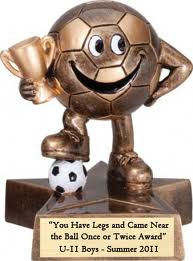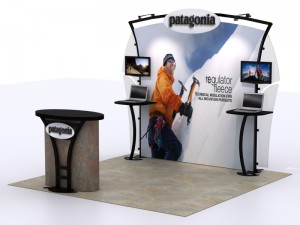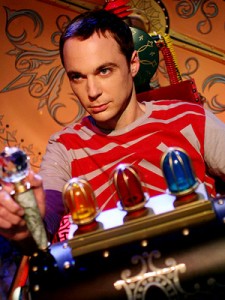Stand on the Podium
The Sochi Winter Olympics is just around the corner. We love watching the competition — who wins, who loses, and the inspiring stories about athletes who participate but do not win a gold, a silver, or a bronze medal. Athletes want to win, even if they know it’s a long shot, so they plan, prepare, and train for a chance to stand on the podium. No one prepares for the Olympics just to win a participation trophy.
Trade shows are no different. For anyone new to trade show marketing, here’s an important tip no one’s ever going to share with you (except me). You can waste LOTS and LOTS of MONEY participating in trade shows if you don’t know what you’re doing. I don’t care how smart you are. You are going to make mistakes. Lots of them, but the key is to minimize them from the get-go. The trick — learn from the folks who have already made those mistakes and who have stubbed their toe(s) more times than they want to be reminded.
Here’s what they’ll tell you.
#1. What’s Your Goal. Why are you participating in a trade show? To build the brand, increase sales, meet new customers, find new markets. All are legitimate reasons to exhibit at a show. Bad reasons . . . Going on a whim, because it sounds like a good idea, or because your dog Rex tells you to go (What a bad boy!). Without a goal you have no way of measuring your success. Get a goal. Write it down and share it with your team. Then and only then should you consider trade show marketing.
#2. What’s Your Budget. If you say, I don’t know then fold up your tent and go home. The number doesn’t matter, except as a baseline for what you can and can’t do. It’s all relative. $10,000 will get you one thing . . . . $250,000 will get you something else.
#3. Do Some Preliminary Research. It’s easy. It’s called Google. Is it going to confuse you? Hell yes. You’ll see stupid numbers like $79 for a banner stand and $1.5 million for a custom exhibit. Imagine walking into a new car lot not having seen or driven a car before. You need a point of reference, but you don’t need to be an expert. That’s impossible. You just need to get a sense of what’s on the market and how much displays cost. That’s it.
#4. Work with a Seasoned Exhibit Professional. Why? Why not! I’ve never met anyone in this business who wants a customer to buy the wrong display. You’ve got a budget, right? That will narrow the choices. During the initial meetings, an exhibit consultant will spend more time talking to you about your goals, your message, and your shows than they will about what display to buy. The display is important, but it’s simply a tool. They want you to succeed. Then you’ll come back and buy more. Yippee! It’s a win-win.
#5 What Shows. Now you may already know which show(s) you must attend. Every industry has a trade show. That’s the first step but hardly the only step. Are their other shows you should attend because you want to expand into other markets? How about local shows where all you need is a table top display or a pop up. Ask your vendors which shows they attend. Or use one of many online tools like the www.thetradeshowcalendar.com. Or, here’s a thought — ask your exhibit professional to assist you.
#6. Plan, Plan, Plan. I know. It’s boring. But, apart from identifying your trade show marketing goals, nothing is more important. You need to put in the work. You need to complete the required paperwork on time. You need to conduct pre-show marketing to get potential clients to your booth. You need to create a project list and check and double-check every last detail. You’ve heard it a million times, but this time it’s true: Fail to plan, then plan to fail. Planning makes the difference between pouring money down a rat-hole and complaining that trade shows don’t work and becoming the next CEO of your company. Well, that may be a little exaggeration (but not much).
#7. Who’s Going to the Show. Working the booth is neither a punishment nor a vacation. It’s a job. There’s no in-between. The folks who work the booth have to understand that. They must know the products and services, possess outstanding customer service skills, and be willing to meet clients before, during, and after the show. They must know the difference between entertaining clients and a felony. They must understand the distinction between social drinking and detox. If they don’t, no matter how charming they are, leave them home.
#8 Train Them. Yes, train them. Before the show, meet with your team and review the goals, the schedule, and the products
and services. Who handles which product line? Who’s the expert on specific services? Who greets clients as they enter the booth? How do you plan to handle leads? Are there meetings and presentations in the booth space? Who cleans in the morning? Who cleans in the evening? How do you handle competitors who enter your booth? There’s a lot of questions and situations that can happen during a one to three day trade show. Do not leave them to chance!
#9. Leads. Treat them like a credit card. You never know if the limit is $500 or if you found an American Express Platinum with no limit. There are really three keys to managing leads. First, qualify the lead and take lots and lots of notes. You may think you have an eidetic memory, but trust me, unless you are Sheldon Cooper on The Big Bang Theory, you don’t. All the details you capture only increase your odds exponentially of making a sale. Knowledge is power on the trade show floor. Second, review the leads with the team at the end of the day. Don’t leave the booth and head for the bar UNTIL you’ve reviewed every single lead. Those that need immediate action should be handed to the right person that day. Third, they are sales leads, not confetti. Too many companies treat them like scraps of paper which can be tossed at the end of the show. How you treat leads tells the potential customer everything about your company.
#10. Post-show Analysis. All too often, when the show is over, the show is over until next year. Big mistake. We learn from our successes and our failures. The trade show team should conduct a “post-show” review within a week. These ideas need to be captured and recorded so the lessons learned can be implemented at the next show. Even better, meet with your trade show consultant as well. He/she can offer advice based on their experience with other clients and show you how you can improve your trade show marketing and save money.
Don’t be shy. Put in the effort and plan ahead and you will be standing on the podium wearing a little gold.
— Mel White
http://www.linkedin.com/in/melmwhite
mel@classicexhibits.com
*********************************
Based in Portland, Oregon, Classic Exhibits Inc. designs and manufacturers portable, modular, and custom-hybrid exhibit solutions. Classic Exhibits products are represented by an extensive distributor network in North America and in select International markets. For more information, contact us at 866-652-2100 or www.classicexhibits.com.
Tags: banner stands, displays, exhibits, marketing, pop up displays, Trade Shows






